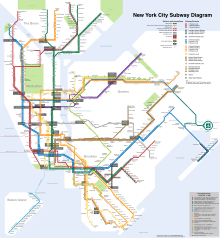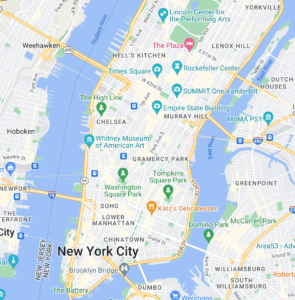 NEW YORK CITY MAP, MAP OF NEW YORK
NEW YORK CITY MAP, MAP OF NEW YORK
NYC MAP
NEW YORK CITY MAP ( NYC MAP ), The New York City Map shows you around the 100 best attractions you must see and in New York City you can find everything that the soul is looking for. NYC is the place where people from all over the world come at least once in a lifetime and many can’t stand the thought of not coming back. NYC is magnificent, modern and the world’s most amazing city. The city that never sleeps. Here you can wake up every morning and see something new. There are places in New York City that must be seen and then there are places you should NOT see.
Map of New York City is your file explorer that you can take with you on your phone or print. Nice trip
New York City
New York is the most populous city in the United States and the nucleus of the premier gateway for legal immigration to the United States—the New York metropolitan area, one of the most populous urban agglomerations in the world. The city is referred to as New York City or the City of New York to distinguish it from the State of New York, of which it is a part. A global power city, New York exerts a significant impact upon commerce, finance, media, art, fashion, research, technology, education, and entertainment. The home of the United Nations Headquarters, New York is an important center for international diplomacy and has been described as the cultural and financial capital of the world.
On one of the world’s largest natural harbors, New York City consists of five boroughs, each of which is a county of New York State. The five boroughs—the Bronx, Brooklyn, Manhattan, Queens, and Staten Island—were consolidated into a single city in 1898. With a census-estimated 2013 population of 8,405,837 distributed over a land area of just 305 square miles (790 km2), New York is the most densely populated major city in the United States. As many as 800 languages are spoken in New York, making it the most linguistically diverse city in the world. By 2013 census estimates, the New York City metropolitan region remains by a significant margin the most populous in the United States, as defined by both the Metropolitan Statistical Area (19.9 million residents) and the Combined Statistical Area (23.5 million residents). In 2012, the MSA produced a gross metropolitan product (GMP) of over US$1.33 trillion, while the CSA generated a GMP of over US$1.55 trillion, both ranking first nationally by a wide margin and behind the GDP of only twelve nations and eleven nations, respectively.
New York traces its roots to its 1624 founding as a trading post by colonists of the Dutch Republic and was named New Amsterdam in 1626. The city and its surroundings came under English control in 1664. New York served as the capital of the United States from 1785 until 1790. It has been the country’s largest city since 1790. The Statue of Liberty greeted millions of immigrants as they came to America by ship in the late 19th and early 20th centuries and is a globally recognized symbol of the United States and its democracy.
Geography
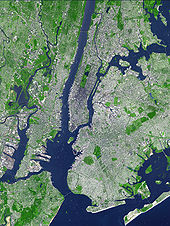
Satellite imagery illustrating the core of the New York City Metropolitan Area.
New York City is in the Northeastern United States, in southeastern New York State, approximately halfway between Washington, D.C. and Boston. The location at the mouth of the Hudson River, which feeds into a naturally sheltered harbor and then into the Atlantic Ocean, has helped the city grow in significance as a trading port. Most of New York City is built on the three islands of Long Island, Manhattan, and Staten Island, making land scarce and encouraging a high population density.
The Hudson River flows through the Hudson Valley into New York Bay. Between New York City and Troy, New York, the river is an estuary. The Hudson separates the city from New Jersey. The East River—a tidal strait—flows from Long Island Sound and separates the Bronx and Manhattan from Long Island. The Harlem River, another tidal strait between the East and Hudson Rivers, separates most of Manhattan from the Bronx. The Bronx River, which flows through the Bronx and Westchester County, is the only entirely fresh water river in the city.
The city’s land has been altered substantially by human intervention, with considerable land reclamation along the waterfronts since Dutch colonial times; reclamation is most prominent in Lower Manhattan, with developments such as Battery Park City in the 1970s and 1980s. Some of the natural relief in topography has been evened out, especially in Manhattan.
The city’s total area is 468.9 square miles (1,214 km2). 164.1 sq mi (425 km2) of this is water and 304.8 sq mi (789 km2) is land.
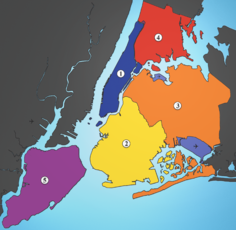
Boroughs of New York City: 1: Manhattan 2: Brooklyn 3: Queens 4: The Bronx 5: Staten Island
New York City is composed of five boroughs. Throughout the boroughs there are hundreds of distinct neighborhoods, many with a definable history and character to call their own. If the boroughs were each independent cities, four of the boroughs (Brooklyn, Queens, Manhattan, and The Bronx) would be among the ten most populous cities in the United States.
The highest point in the city is Todt Hill on Staten Island, which, at 409.8 feet (124.9 m) above sea level, is the highest point on the Eastern Seaboard south of Maine. The summit of the ridge is mostly covered in woodlands as part of the Staten Island Greenbelt.
Cityscape
Architecture

Landmark 19th-century rowhouses on tree-lined Kent Street in Greenpoint Historic District, Brooklyn

One World Trade Center, the tallest skyscraper in the Western Hemisphere, is located in Lower Manhattan.
New York City has architecturally noteworthy buildings in a wide range of styles and from distinct time periods, from the saltbox style Pieter Claesen Wyckoff House in Brooklyn, the oldest section of which dates to 1656, to the modern One World Trade Center, the skyscraper currently under construction at Ground Zero in Lower Manhattan and currently the most expensive new office tower in the world.
The 1916 Zoning Resolution required setbacks in new buildings, and restricted towers to a percentage of the lot size, to allow sunlight to reach the streets below. The Art Deco style of the Chrysler Building (1930) and Empire State Building (1931), with their tapered tops and steel spires, reflected the zoning requirements. The buildings have distinctive ornamentation, such as the eagles at the corners of the 61st floor on the Chrysler Building, and are considered some of the finest examples of the Art Deco style. A highly influential example of the international style in the United States is the Seagram Building (1957), distinctive for its façade using visible bronze-toned I-beams to evoke the building’s structure. The Condé Nast Building (2000) is a prominent example of green design in American skyscrapers.
Stone and brick became the city’s building materials of choice after the construction of wood-frame houses was limited in the aftermath of the Great Fire of 1835. A distinctive feature of many of the city’s buildings is the wooden roof-mounted water towers. In the 1800s, the city required their installation on buildings higher than six stories to prevent the need for excessively high water pressures at lower elevations, which could break municipal water pipes. Garden apartments became popular during the 1920s in outlying areas, such as Jackson Heights.
The Condé Nast Building, officially Four Times Square, is a modern skyscraper in Times Square in Midtown Manhattan and one of the most important examples of green design in skyscrapers in the United States. Environmentally friendly gas-fired absorption chillers, along with a high-performing insulating and shading curtain wall, ensure that the building does not need to be heated or cooled for the majority of the year. Office furniture is made with biodegradable and non-toxic materials. The air-delivery system provides 50% more fresh air than is required by New York City Building Code, and a number of recycling chutes serve the entire building. Being the first project of its size to undertake these features in construction, the building has received an award from the American Institute of Architects, as well as AIA New York State. New York has 56 skyscrapers that are over 200 meters.
Climate

Avenue C in Manhattan after flooding caused by Hurricane Sandy on October 29, 2012. Hurricane Sandy (unofficially known as “Superstorm Sandy”) was the deadliest and most destructive hurricane of the 2012 Atlantic hurricane season, as well as the second-costliest hurricane in United States history.
Under the Köppen climate classification, using the 0°C coldest month (January) isotherm, New York City itself experiences a humid subtropical climate (Cfa), and New York is thus the northernmost major city on the North American continent with this categorization. The suburbs to the immediate north and west lie in the transition zone from a humid subtropical (Cfa) to a humid continental climate (Dfa). The area averages 234 days with at least some sunshine annually, and averages 57% of possible sunshine annually, accumulating 2,535 hours of sunshine per annum. The city falls under USDA 7b Plant Hardiness zone.
Winters are cold and damp, and prevailing wind patterns that blow offshore minimize the moderating effects of the Atlantic Ocean; yet the Atlantic and the partial shielding from colder air by the Appalachians keep the city warmer in the winter than inland North American cities at similar or lesser latitudes such as Pittsburgh, Cincinnati, and Indianapolis. The daily mean temperature in January, the area’s coldest month, is 32.6°F; however, temperatures usually drop to 10°F several times per winter, and reach 50°F several days each winter month. Spring and autumn are unpredictable and can range from chilly to warm, although they are usually mild with low humidity. Summers are typically warm to hot and humid, with July daily mean temperature of 76.5°F. Nighttime conditions are often exacerbated by the urban heat island phenomenon, while daytime temperatures exceed 90°F on average of 17 days each summer and in some years exceed 100°F. Extreme temperatures have ranged from −15°F, recorded on February 9, 1934, up to 106°F on July 9, 1936.
Transportation
New York City’s comprehensive transportation system is both complex and extensive.
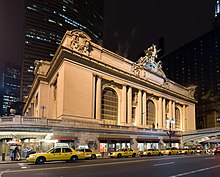
New York City is home to the two busiest rail stations in the US, including Grand Central Terminal.
Rail
Mass transit in New York City, most of which runs 24 hours a day, accounts for one in every three users of mass transit in the United States, and two-thirds of the nation’s rail riders live in the New York City Metropolitan Area. The iconic New York City Subway system is the busiest in the Western Hemisphere, while Grand Central Terminal, also popularly referred to as “Grand Central Station”, is the world’s largest railway station by number of platforms.
Public transport is essential in New York City. 54.6% of New Yorkers commuted to work in 2005 using mass transit. This is in contrast to the rest of the United States, where about 90% of commuters drive automobiles to their workplace. According to the US Census Bureau, New York City residents spend an average of 38.4 minutes a day getting to work, the longest commute time in the nation among large cities. New York is the only US city in which a majority (52%) of households do not have a car; only 22% of Manhattanites own a car. Due to their high usage of mass transit, New Yorkers spend less of their household income on transportation than the national average. New Yorkers save $19 billion annually on transportation compared to other urban Americans.

The New York City Subway is the world’s largest rapid transit system by length of routes and by number of stations.
New York City is served by Amtrak, which uses Pennsylvania Station. Amtrak provides connections to Boston, Philadelphia, and Washington, D.C. along the Northeast Corridor and long-distance train service to other North American cities. The New York City Subway is the largest rapid transit system in the world when measured by stations in operation, with 468, and by length of routes. It is the third-largest when measured by annual ridership (1.5 billion passenger trips in 2006). New York’s subway is also notable because nearly the entire system remains open 24 hours a day, in contrast to the overnight shutdown common to systems in most cities, including Hong Kong, London, Paris, Seoul, and Tokyo.
New York City’s commuter rail network is the largest in North America. The rail network, connecting the suburbs in the tri-state region to the city, consists of the Long Island Rail Road, Metro-North Railroad, and New Jersey Transit. The combined systems converge at Grand Central Terminal and Pennsylvania Station and contain more than 250 stations and 20 rail lines.
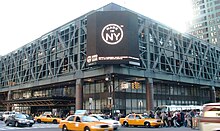
The Port Authority Bus Terminal, the world’s busiest bus station, at 8th Avenue and 42nd Street.
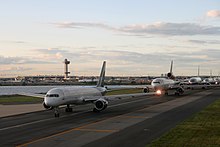
As of 2011, JFK International Airport in Queens was the busiest airport for international passengers in North America.
The Staten Island Railway rapid transit system solely serves Staten Island, operating 24 hours a day. The Port Authority Trans-Hudson (PATH train) links Midtown and Lower Manhattan to northeastern New Jersey, primarily Hoboken, Jersey City, and Newark. Like the New York City Subway, the PATH operates 24 hours a day; meaning three of the six rapid transit systems in the world which operate on 24-hour schedules are wholly or partly in New York (the others are a portion of the Chicago ‘L’, the PATCO Speedline serving Philadelphia, and the Copenhagen Metro).
Buses
The region’s public bus fleet is the world’s largest, and the Port Authority Bus Terminal, the main intercity bus terminal of the city, serves 7,000 buses and 200,000 commuters daily, making it the busiest bus station in the world.
Air
New York’s airspace is the busiest in the United States and one of the world’s busiest air transportation corridors. The New York metropolitan area is served by three major airports, John F. Kennedy International, Newark Liberty International, and LaGuardia; 109 million travelers used the three airports in 2012, and the city’s airspace is the busiest in the nation. JFK and Newark Liberty were the busiest and fourth busiest U.S. gateways for international air passengers, respectively in 2012. Plans have advanced to expand passenger volume at a fourth airport, Stewart International Airport near Newburgh, New York, by the Port Authority of New York and New Jersey.

The Verrazano-Narrows Bridge, one of the world’s longest suspension bridges connects Brooklyn and Staten Island across The Narrows.



